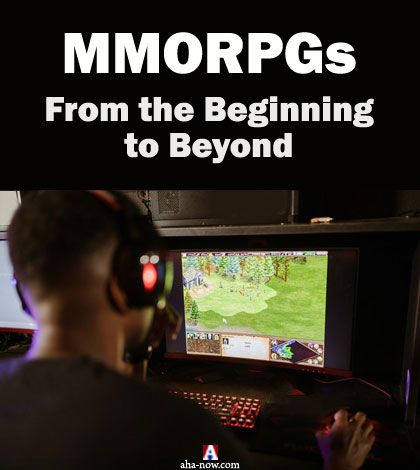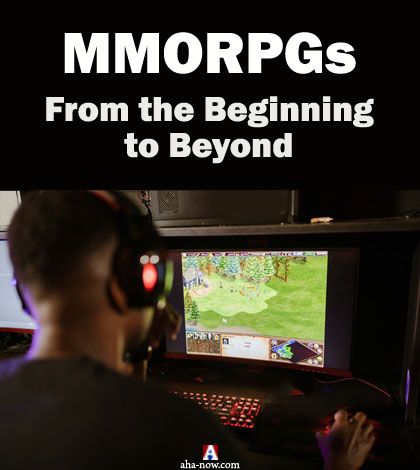
Online games have come of age. Starting from the 70s on ARPANET to the full-fledged MMORPGs in the 21st century, this genre of games has evolved significantly. RuneScape is testimony of the over two decades of MMORPGs history among other popular games that have captivated people all over the globe. Here is the story of the beginning and becoming of MMORPGs that every gamer needs to know. ~ Ed.

MMORPGs (Massively Multiplayer Online Role-Playing Games) are a genre of games that almost all gamers are very familiar with.
Every player has been through their taste of an RPG game, playing along a story set in some fantasy role-playing universe fighting in dungeons, hacking down goblins for some “exp” and level ups, along with the MMO element added, bringing players from far and wide together on a platform.
Like every other genre, some people love these games and there are people who are not so much in favor of it. At many points in time, people have stated that the MMORPG genre is gaining a severe decline and might disappear into history. But despite all that, MMOs have lived far longer than most genres and still tend to be going strong.
Beginnings of MMORPGs
MMOs have existed for longer than you can imagine. Back in the 1970s, games called MUDS, followed by Graphical MUDs, existed with the same base ideologies and laid the foundation for the MMORPG genre. These MUDs, or Multi-User Dungeons, could be played online by several users on the ARPANET, the predecessor of the modern-day worldwide web; the Internet.
These MUDs carried the standard rules and regulations similar to the most board, tabletop role-playing games. Due to the multiplayer aspect, MUDs became somewhat popular. Why somewhat? Several limiting factors prevented MUDs from being the big deal of the 70s and 80s. One of these factors was the high costs of connectivity at that time, with longer distances meaning much greater costs to connect people and allow them to play together.
Also to keep in mind ARPANET speeds were nowhere near the speed of the Internet, even if compared to the Internet from its earlier days. Players that played together and were connected over longer distances would experience delays and lag because of the slower transmission speeds. Moreover, the fact that the ARPANET was available for a short amount of time after midnight, from 2 A.M. to 8 A.M., made it even more difficult for online gaming to progress.
MUDs also lacked any form of graphics at that time and all attributes and details of the player’s character, fellow players, enemies, their moves, and everything else was in the form of text, as the games were played on a DOS-based interface. Several MUDs even introduced a subscription fee for the sake of revenue generation and sustainability of the games; an element that created the most uproar amongst the public.
The Days of Graphical MUDs
Despite all the odds against them, MUDs lived on and grow into Graphical MUDs, carrying on the same set of rules and mechanics but with still images and graphic elements that brought more life to the games. Graphical MUDs like their predecessors also allowed the players to have in-game chat and chat environments, generally similar to chat rooms and lobby settings in modern-day gaming. Habitat was one of the earliest prominent titles amongst the pioneer Graphical MUDs and was released in 1985.
Gradually, the graphics of Graphical MUDs started to get better and improved more as the technology advanced. With stronger computing systems and faster and cheaper connections through the Internet, the industry moved towards games supporting massive pools of players on a global scale. Soon, the term Graphical MUDs got out of use and was replaced with “Massively Multiplayer Online Role-Playing Games” or MMORPGs, a term coined by Richard Garriott in 1997.
The Becoming of MMORPGs
From there on, in over two decades, MMORPGs have greatly expanded with several title releases from different developers and corporations. Each of these tends to go with its unique elements, differentiating it from the others while staying true to their core values that are present in every MMORPG to date.
For instance, some of these games offer open worlds to explore and unravel while interacting with fellow players. Others go along with a storyline that players can join in on together to accomplish missions, explore the region, or even tag team to take down bosses.
To better understand the development of MMORPGs in the past two decades, let us look at a popular name prevalent in the genre.
RuneScape
One of the longest-running titles of the MMORPG genre is RuneScape. The game came forward with an initial release in 2001, by the company that has ever since developed and published it; Jagex Limited.
The game is set in a fantasy world of Gielinor, which is further divided into its own set of fictitious cities, regions, and realms. The in-game world offers diversity by giving the player the chance to encounter different kinds of monsters, find unique items and obtain quests to accomplish in each of these separate regions.
The game developed from its initial beta version, which was released as RuneScape 1 then later dubbed as RuneScape Classic, to its second release titled RuneScape 2. This release came forward in 2004 with the addition of a new game engine and 3D character sprites and game models, changing the game interface drastically, which favored some gamers while disappointing others. After this, Jagex started to look into international distributions and translations of the game, which helped increase its player base and popularity.
Later on a HTML5 compatible version of RuneScape was released titled RuneScape 3, in July 2013. Slightly prior, Old School RuneScape was released in February 2013 based on an archived version from 2007, to win over the players the company lost because of the introduction of micro-transactions, by introducing this release as a completely free-to-play model. The initial release was for MS Windows and macOS, but later in October 2018, the game was released for Android and iOS devices, making it the most downloaded game in 8 countries surpassing a million downloads in less than two weeks. RuneScape 3 was available on Steam in October 2020 and not too far behind followed Old School RuneScape in February 2021.
Wrapping it Up
RuneScape may be a big name in the MMORPG world but it is not alone. Several popular game titles such as World of Warcraft, Guild Wars, Black Desert Online, Star Wars: The Old Republic, Elder Scrolls Online and Albion Online exist that are tied to this vast genre with a long history.
Notably, currently Albion Online Silver is surprisingly cheap. Moreover, many titles should be expected in the near future as Augmented and Virtual Reality (AR and VR) based MMORPGs are also in the works, based on the ideas and elements presented by the Japanese anime series, Sword Art Online (SAO), which itself centered on the story of an MMO game. Thus, it is safe to say that with all the years of buildup this genre has gained, it is not going anywhere soon.
Over to you
What do you think about the future of MMO games? Share your thoughts in the comments section.
Disclosure: This is a sponsored post and the views presented are entirely of the sponsorer.


